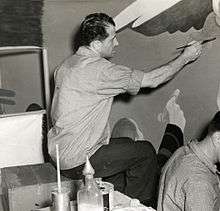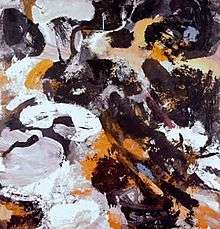James Brooks (painter)
James D. Brooks (October 18, 1906 – March 9, 1992) was an American muralist, abstract painter, and winner of the Logan Medal of the Arts.
James D. Brooks | |
|---|---|
 Brooks working on a mural, 1940 | |
| Born | October 18, 1906 St. Louis, Mo. |
| Died | March 9, 1992 (aged 85) |
| Nationality | American |
| Known for | Painting, Muralism |
| Movement | Abstract Expressionism, Action painting, Lyrical Abstraction |
Life and career
Brooks was born in St. Louis, Missouri and attended Southern Methodist University and the Dallas Art Institute[1] and moved to New York in 1926 where he attended night classes at the Art Students League.
Between 1942 and 1945, Brooks was enlisted as a combat artist with the American military. Based in Cairo, he traveled to Palestine, Benghazi, Libya, and other parts of Egypt during this time, photographing American military camps, the aftermath of combat, and locals. From these photographs, he created a series of drawings and gouache paintings that were then submitted to the army. Upon returning to the U.S. in 1946, he worked in Washington D.C., where he first met artist Charlotte Park.
Brooks was a friend of Jackson Pollock and Lee Krasner and would move into Pollock's Greenwich Village apartment at 46 East 8th Street after Pollock and Krasner moved to Springs, New York in East Hampton, New York.[2]
In 1947 he married artist Charlotte Park. They also moved to East Hampton in 1949 creating a studio at Rocky Point in Montauk, New York. The Montauk studio and several of Brooks paintings were destroyed in Hurricane Carol with the studio being blown off a hill in 1954. Brooks then had their house which was not damaged towed by barge across to Springs where it was located on an 11-acre parcel on Neck Path close to Pollock's home. Brooks and Park had no children and their property after the house and studios were left vacant was sold to East Hampton in 2013 with the town planning to tear it down. The town reconsidered their decision in February 2017 to tear down following a local campaign to restore the compound and instead announced plans to restore the studio and house. Town officials noted Brooks paint cans were still in the studio.[3][4][5]
Considered a first generation abstract expressionist painter, Brooks was among the first abstract expressionists to use staining as an important technique. According to art critic Carter Ratcliff,[6] "His concern has always been to create painterly accidents of the kind that allow buried personal meanings to take on visibility." In his paintings from the late 1940s Brooks began to dilute his oil paint in order to stain the mostly raw canvas. These works often combined calligraphy and abstract shapes.
Brooks had his first one-man exhibition of his abstract expressionist paintings in 1949 at the Peridot Gallery in New York. His work was displayed in the 9th Street Art Exhibition in 1951.

Public collections holding works by James Brooks include: the Governor Nelson A. Rockefeller Empire State Plaza Art Collection (Albany, NY),[7] Courtauld Institute of Art (London), the Dallas Museum of Art (Dallas, Texas), the Museum of Modern Art (New York, NY), the Harvard University Art Museums, the Whitney Museum of American Art (New York, NY), the Honolulu Museum of Art, the Indianapolis Museum of Art (Indianapolis, Indiana), the Sheldon Art Gallery (Lincoln, Nebraska), the Smithsonian American Art Museum (Washington D.C.), the Tate Gallery (London) and the Walker Art Center (Minneapolis, Minnesota). His works were also exhibited by galleries including the Anita Shapolsky Gallery in New York City, the Peridot Gallery in New York, and Washburn Gallery in New York.[8][9][10]
Studied
- 1923–1926: Southern Methodist University; Dallas Art Institute and with Martha Simkins.
- 1927–1930: The Art Students League of New York, New York City; night classes with Kimon Nicolaides and Boardman Robinson.
Brooks worked as a commercial letterer and display artist to support himself.
_in_the_former_Little_Falls%2C_NJ_Post_Office.jpg)
Participated in the Federal Art Project (WPA)
Brooks participated in the Federal Art Project through the US Department of the Treasury's Section of Fine Arts between 1936 and 1942. By submitting design proposals to several competitions, he was able to secure three significant public works commissions. Between 1938 and 1942, he painted a 235-foot mural entitled "Flight" around the rotunda of the Marine Air Terminal at La Guardia Airport. A 1937 mural painted in a public library in Woodside, Queens was destroyed in the 1960s. The only other surviving mural by Brooks is located in the Little Falls Civic Center in New Jersey. Titled "Labor and Leisure" the Little Falls mural was completed in 1938. His Marine Air Terminal mural was painted over by the Port Authority in the 1950s but was restored in 1980.[11]
Teaching positions
- 1947–1948: Columbia University, New York
- 1948–1955: Pratt Institute
- 1955–1960: Yale University, New Haven, Connecticut
- 1963: Artist-in-residence at the American Academy, Rome, Italy
- 1965–1967: New College, Sarasota, Florida
- 1966: Miami Beach Art Center, Miami Beach, Florida
- 1966–1969: Queens College, New York
- 1971–1972: University of Pennsylvania
- 1975: Cooper Union, New York City
See also
- Abstract expressionism
- Abstract Imagists
- Lyrical Abstraction
- Inscape (visual art)
References
- KENDALL, CURLEE (June 12, 2010). "DALLAS ART INSTITUTE". tshaonline.org. Archived from the original on February 3, 2018. Retrieved February 3, 2018.
- "Paid Notice: Deaths BROOKS, CHARLOTTE PARK". February 3, 2018. Archived from the original on June 12, 2018. Retrieved June 12, 2018 – via NYTimes.com.
- "East Hampton Town To Consider Preserving Artists' Studios In Springs - Springs". Archived from the original on February 3, 2018. Retrieved February 3, 2018.
- "Property". Brooks Park Heritage Project. Archived from the original on February 3, 2018. Retrieved February 3, 2018.
- "East Hampton To Spend $850K To Restore Artists' Studio And Home In Springs - Springs". Archived from the original on February 2, 2018. Retrieved February 3, 2018.
- Art International, February 1973. pp 38–39
- "Empire State Plaza Art Collection". Archived from the original on November 6, 2018. Retrieved November 21, 2018.
- "The Location of the Second Generation". New York Sun. Archived from the original on July 23, 2015. Retrieved March 18, 2015.
- James Brooks. 1994. Archived from the original on April 14, 2016. Retrieved March 18, 2015.
- Edwards, Katie Robinson (July 2014). Midcentury Modern Art in Texas. ISBN 9780292756656. Archived from the original on April 20, 2016. Retrieved March 18, 2015.
- "James Brooks, an Artist, Is Dead; Abstract Expressionist Was 85". The New York Times. March 12, 1992. Archived from the original on January 16, 2018. Retrieved February 3, 2018.
Books
- "James Brooks (1906–1992): Mounted Policeman (New York Policeman)". Mark Borghi Fine Art Inc. Archived from the original on April 4, 2005. Retrieved June 8, 2005.
Article
- Sandler, Irving H. "James Brooks and the abstract inscape", ARTnews (New York: Art Foundation, 1963) OCLC: 54034429
External links
- Van Doren Waxter Gallery
- James Brooks Abstract Expressionsim-New York School 1950s on YouTube
- James Brooks: My whole tendency has been away from the fast moving line either violent or lyrical. —MOMA, Ann Tenpkin curator, AUDIO James Brooks. Qualm. 1954
- Brooklyn Rail, "Unlikely Friends: James Brooks & Dan Flavin."